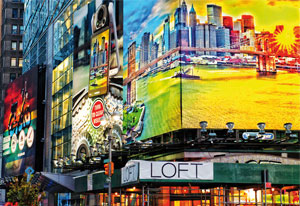 By Roland Biemans
By Roland Biemans
One of the most interesting trends relating to the digital textile printing market is how regional factors have been gaining strength, enabling a noticeable shift of decorated fabric production back to Canada and other western countries. While inexpensive commodity textiles are still not part of this trend, it is becoming increasingly common to digitally print textiles for point-of-purchase (POP) displays closer to the retailers who use them. In the past, these clients would order large quantities of printed fabrics and then draw upon that supply for longer periods. Today, production is going digital and local, courtesy of sign shops and print service providers (PSPs).
This arrangement will drive digital textile printing forward because it offers many benefits to these customers. There is less uncertainty about delivery times, material choices and print quality. As the market shifts to ‘print on demand,’ transportation costs are reduced, as are inventory storage requirements.
It has also become possible for local signs shops to offer broader choices in wide-format graphics, given the availability of different types of digitally printable fabrics in more sizes and with wider pricing variations.
Together, these capabilities have made it more cost-effective and feasible to print fabrics on demand for major events, like the recent Fédération Internationale de Football Association (FIFA) World Cup, where timing is critically important.

With today’s variety of digitally printable fabrics, sign shops can offer broader choices in wide-format graphics, including larger sizes.
Now that this trend is working well in one market, there will be a push to extend it to others. The garment industry, for example, could experience the same benefits in terms of delivery time, quality and warehousing as have been seen for banners and flags. As such, these factors could help offset the cost differences between domestic and overseas production of clothing. Quantities and size requirements could be readily adjusted in accordance with shifts in supply and demand and the volume of unsold stock would be greatly reduced, helping retailers and manufactures avoid the need to deeply discount or even destroy extra goods.
Scaling up technology
The trend is enabled by technology. While there are still further developments to be made in digital textile printing, it is now more of a matter of ‘scaling up’ existing systems, rather than one of waiting for the next technological breakthrough.
There are already printheads suitable for full production runs, for example. And a shift away from using solvent-based inks with volatile organic compounds (VOCs) and even ultraviolet-curable (UV-curable) inks, in favour of dye sublimation and durable aqueous ‘latex’ inks, is also playing a part in attracting textile decoration work back to countries like Canada. Water-based inks, especially, are an asset to traditional textile buyers, as they meet many standards for environmental certification.
Ink formulators, in turn, are working with printhead developers and printer manufacturers to ensure inks are designed for new printers before they reach the market. Some of these are ‘original equipment manufacturer’ (OEM) inks developed
for specific brands, while others are marketed as third-party or after-market inks.
There can be challenges when choosing between after-market ink suppliers. Some of these companies have built up strong expertise over a long period and continue to do so with active research and development (R&D) teams and continuous training. In addition to well-established relationships with customers, they are also on good terms with the printer manufacturers. Indeed, they may well also develop OEM inks at the same time.

It has become more cost-effective and feasible to print fabrics on demand for major events.
Others, however, try to develop and sell inks on price alone or opportunistically produce small quantities of inks for local markets without offering quality assurance or support. For these reasons, the image of after-market and third-party inks is mixed at best. There is a big difference between suppliers who put extensive effort into testing, sampling, profiling, certifying and investing in new ink technologies and those who do not.
So, when choosing a supplier, it is important to distinguish between them on this basis. Low price alone may not deliver the best value if it means a severe compromise in quality, reliability and consistency. There needs to be trust in the product.
Understanding the differences
The term ‘textile printing’ only makes sense in reference to a general, collective market. There is no other way to describe the printing of banners, soft signs, flags, carpets, interior décor, upholstery, garments and other textile applications within a single term.
Within the textile printing market, the differences between each type of substrate can be significant. Each material has its own characteristics and requires its own printing and finishing processes.





